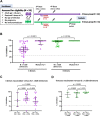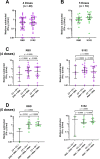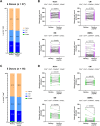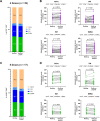A two-arm analysis of the immune response to heterologous boosting of inactivated SARS-CoV-2 vaccines
- PMID: 37907584
- PMCID: PMC10618206
- DOI: 10.1038/s41598-023-46053-8
A two-arm analysis of the immune response to heterologous boosting of inactivated SARS-CoV-2 vaccines
Abstract
Several vaccine programs were introduced during the COVID-19 pandemic, which included inactivated virus, DNA viral vectors and mRNA vaccines. Booster programs are recommended, especially for those in high-risk groups. However, many of these booster programs involve heterologous vaccines. This study enrolled volunteers who first received two full-dose CoronaVac vaccinations before receiving heterologous boosters with DNA- and/or mRNA-vaccines for an additional 2 doses (n = 40) or an additional 3 doses (n = 16). Our results showed no difference in side effects, neutralizing antibodies, or T-cell responses for any of the heterologous vaccination programs. However, the neutralizing capacity and IFN-γ responses against the Omicron variant in volunteers who received 4 or 5 doses were improved. Polarization of peripheral memory T cells after stimulation in all booster groups with Omicron peptide showed an increased trend of naïve and central memory phenotypes of both CD4+ and CD8+ T cells, suggesting that exposure to Omicron antigens will drive T cells into a lymphoid resident T cell phenotype. Our data support a continuous vaccination program to maximize the effectiveness of immunity, especially in people at high risk. Furthermore, the number of boosting doses is important for maintaining immunity.
© 2023. The Author(s).
Conflict of interest statement
The authors declare no competing interests.
Figures




Similar articles
-
Safety and immunogenicity against ancestral, Delta and Omicron virus variants following a booster dose of an inactivated whole-virus COVID-19 vaccine (VLA2001): Interim analysis of an open-label extension of the randomized, controlled, phase 3 COV-COMPARE trial.J Infect. 2023 Sep;87(3):242-254. doi: 10.1016/j.jinf.2023.06.022. Epub 2023 Jul 3. J Infect. 2023. PMID: 37406777 Clinical Trial.
-
Boosting with Multiple Doses of mRNA Vaccine after Priming with Two Doses of Protein Subunit Vaccine MVC-COV1901 Elicited Robust Humoral and Cellular Immune Responses against Emerging SARS-CoV-2 Variants.Microbiol Spectr. 2022 Oct 26;10(5):e0060922. doi: 10.1128/spectrum.00609-22. Epub 2022 Aug 25. Microbiol Spectr. 2022. PMID: 36005765 Free PMC article.
-
Omicron BA.1-specific T-cell responses in adults vaccinated with CoronaVac or BNT162b2 in Hong Kong: an observational cohort study.Lancet Microbe. 2023 Jun;4(6):e418-e430. doi: 10.1016/S2666-5247(23)00006-X. Epub 2023 Apr 20. Lancet Microbe. 2023. PMID: 37086735 Free PMC article.
-
Real-world effectiveness and factors associated with effectiveness of inactivated SARS-CoV-2 vaccines: a systematic review and meta-regression analysis.BMC Med. 2023 Apr 27;21(1):160. doi: 10.1186/s12916-023-02861-3. BMC Med. 2023. PMID: 37106390 Free PMC article.
-
Effect of homologous or heterologous vaccine booster over two initial doses of inactivated COVID-19 vaccine.Expert Rev Vaccines. 2024 Jan-Dec;23(1):283-293. doi: 10.1080/14760584.2024.2320861. Epub 2024 Feb 27. Expert Rev Vaccines. 2024. PMID: 38369699 Review.
Cited by
-
Risk Factors for Impaired Cellular or Humoral Immunity after Three Doses of SARS-CoV-2 Vaccine in Healthy and Immunocompromised Individuals.Vaccines (Basel). 2024 Jul 8;12(7):752. doi: 10.3390/vaccines12070752. Vaccines (Basel). 2024. PMID: 39066390 Free PMC article.
References
-
- Wu N, et al. Long-term effectiveness of COVID-19 vaccines against infections, hospitalisations, and mortality in adults: Findings from a rapid living systematic evidence synthesis and meta-analysis up to December, 2022. Lancet Respir. Med. 2023;11:439–452. doi: 10.1016/S2213-2600(23)00015-2. - DOI - PMC - PubMed
Publication types
MeSH terms
Substances
Supplementary concepts
LinkOut - more resources
Full Text Sources
Medical
Research Materials
Miscellaneous

